
Neatorama is proud to bring you a guest post from history buff and Neatoramanaut WTM, who wishes to remain otherwise anonymous.
In the United States, the decade of the 1920’s, aka the ‘Roaring Twenties’, was the time of the Jazz Age, Art Deco, flappers, the Charleston, the Scopes Monkey Trial, a runaway bull stock market, birth of the NFL, Babe Ruth, first widespread use of the automobile, the beginning of airline aviation, Prohibition, bootleg liquor, Al Capone, speakeasies, gangsters, Eliot Ness and the Untouchables, and what was perhaps the single most iconic object of that era – the Thompson Submachine Gun (TSMG).
The story of the TSMG is a complex blend of patriotism, dreams, intrigue, misguided enthusiasm, greed, disappointment, questionable business practices, and significant unintended consequences. It covers only a short span of American history, from 1920 to 1945, but has had a lasting impact on American culture. It would be hard for anyone today to imagine the Roaring Twenties without a ‘Tommy Gun’ blazing away from the passenger windows of a black sedan or police car on some city street, as seen in the 1960’s TV series, The Untouchables.
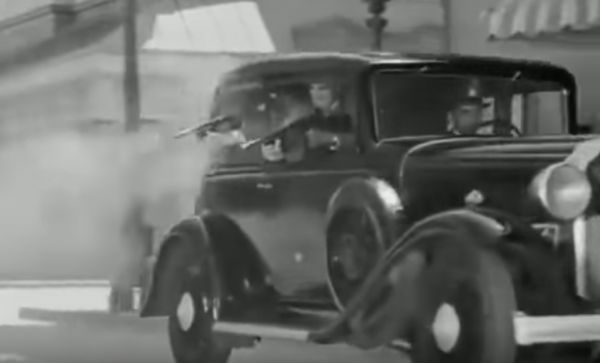
No other firearm has ever captured the public imagination so thoroughly, both at the height of its notoriety and for decades afterwards, as has the TSMG. Even today, nearly 100 years after its introduction, the TSMG is still the iconic submachine gun and ‘gangster gun’. Its role in Roaring Twenties and Threadbare Thirties gangland violence made it infamous despite the fact that it was originally intended for use “On The Side of Law and Order” and was actually more commonly found in the hands of lawmen than criminals during that time. In 1926, Colliers magazine described the TSMG as a “diabolical engine of death” and the attendant negative publicity kept the TSMG from being adopted as a military weapon until it was almost too late.
The father of the TSMG, John Taliaferro Thompson, was born in 1860 and entered the army in 1882, transferring to the Ordnance Department in 1890. Thompson became famous for conducting tests that resulted in adoption of the .45 Automatic Colt Pistol (.45 ACP) as the official U.S. Military handgun cartridge. From these tests it was determined that the .45 ACP was a superior cartridge for a military sidearm, and they led to the 1911 adoption of the Colt .45 M1911 automatic – the famous “.45 Auto” – which is still in service today among elite military Special Forces.
In November 1914 Thompson retired with the intention of devoting his full time to perfecting an automatic rifle. When the United States entered World War I, he was recalled to active duty and promoted to brigadier general. General Thompson had observed firsthand just how unsuitable a rifle was in the confined spaces of the trench networks then dotting the European countryside, and how unsafe it was for a soldier to have to depend on a pistol or bayonet because of it. As such, Thompson envisioned a hand-held version of a machine gun - a portable "trench-sweeping" system capable of operation by a single soldier and optimized for use in close quarters, one that would also give that soldier firepower superior to that of any enemy. The challenge lay in devising a weapon that was simple, reliable, economical, and that could easily be carried by an infantryman under battlefield conditions.
General Thompson set to work designing such a weapon and immediately ran into difficulties, chief among these being potential patent infringements. Other weapons designers such as John Browning had been hard at work during this time, gaining patent after patent, and General Thompson was faced with the hard reality of having to pay royalties to be able to design his own gun. And then Fortune smiled. Twice.
Commander John Blish, U.S. Navy, had in 1915 patented a novel delayed blowback breech system for use in automatic weapons. General Thompson learned of this through his military connections and offered Blish shares in a company he was forming in exchange for the patent. Blish accepted and with the backing of financier Thomas Fortune Ryan, the Auto-Ordnance Company was founded in 1916.
The .45 ACP cartridge had already proven itself to be a potent manstopper in the exhaustive military trials for the Model 1911 .45 pistol and so General Thompson thus conceived and began developing a submachine gun of this caliber, which he called a "Trench Broom." Design proceeded under the name of "Annihilator I".
Basically, a submachine gun is a compact, handheld automatic weapon that fires pistol-caliber ammunition, the most common being the 9mm Parabellum and the .45 ACP, as opposed to the much more powerful light and heavy machine guns that, for example, fire 7.62mm NATO rifle ammunition and .50 caliber Browning Machine Gun (BMG) ammunition respectively. The ‘sub’ prefix was intended to convey that, while this weapon was indeed a machine gun, it was of a lesser ‘sub’ class, being ‘sub’ordinate to the more powerful machine guns of the time.
 Left to Right: .50 BMG, 7.62mm NATO, .45 ACP, 9mm Parabellum ©WTM
Left to Right: .50 BMG, 7.62mm NATO, .45 ACP, 9mm Parabellum ©WTM
The prototype TSMG fed from a 20 round stick magazine, had a finned barrel, two pistol grips, one fore and one aft, and a short buttstock. It also had a profile that was soon to become instantly recognizable all over the world. General Thompson had first coined the term "submachine gun" but the press needed a snappier term to catch the public fancy and hold it, and thus the term "Tommy Gun" was born. Auto-Ordnance actually registered "Tommy Gun" with the Trademark division of the Patent Office and this was even stamped on some of the early production guns.
In short, General Thompson and Commander Blish had created what would become the iconic weapon of the Roaring Twenties and the Threadbare Thirties. The gun they created was reliable, accurate, powerful, and it was one other thing – a work of art. The TSMG thus became a phenomenon that transcended its design, intent, and utility. It was more than the sum of its parts, a perfect example of what might be called charismatic harmony, a curvaceous and brilliantly choreographed mechanical symphony, flawlessly executed in gleaming blued steel and polished hardwood.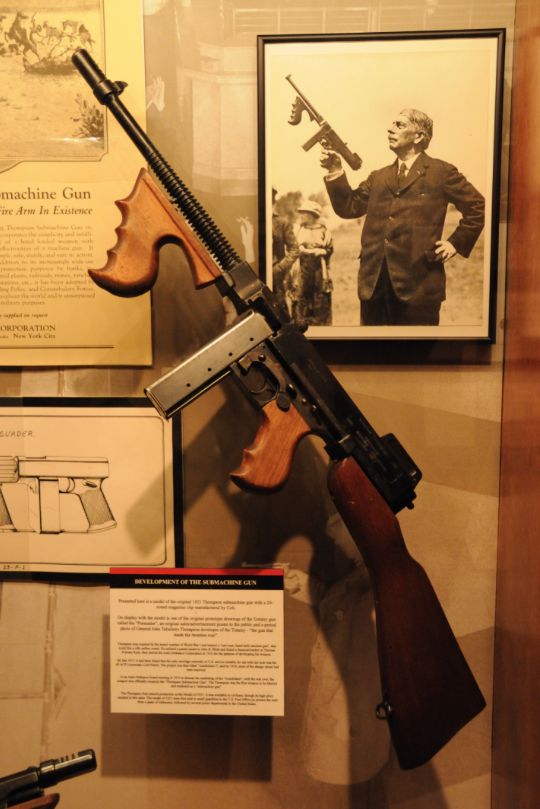
The first prototype TSMG was produced in 1918, too late to be tested, accepted, and used in WWI, and was soon followed by the Model 1919. Provision was made for feeding by stick or drum magazines, while the rear grip was placed near the back of the receiver. The cyclic rate of fire of this prototype was approximately 1500 rpm. 
The TSMG had its first public demonstration in August 1920. Everyone who then witnessed the gun in action was amazed at its compact size and massive firepower and agreed that this was the most revolutionary small arm of its day. The demo gun could empty a one hundred round drum magazine in four seconds. No competing arm could even come close.
At 1500 rpm firing rate, the sound was described as being like “the loud ripping of a rag”. To improve controllability, actual production guns had a lower rate of fire, 600 to 1000 rpm. Listen to it here.
Its potential as a law enforcement tool was recognized in a 1920 issue of Scientific American: “Without doubt the early future will see the happy coincidence of a policeman skilled in the pointing of the new weapon, and an automobile full of yeggs willing to engage in the customary running gun fight. The result will be the worst shot-up assortment of crooks that has ever come to the attention of the coroner.”
The prototype TSMG was also tested by the military in 1920, but due to post–WWI budget constraints, such a relatively expensive firearm was not then seriously considered for adoption. Although the United States, by dint of its military might, had proven to be victorious in WWI, by 1920 Congress was tired of war and of the implements of war. It refused to authorize an arms appropriation that would have enabled the military to purchase the new TSMG in quantity, although some were purchased by branches of the Armed Forces such as the Navy and Coast Guard using their existing budgets. With the military market closed indefinitely, there was only one thing that General Thompson could do – market the TSMG directly to law enforcement and the home consumer. Yes, you read that right.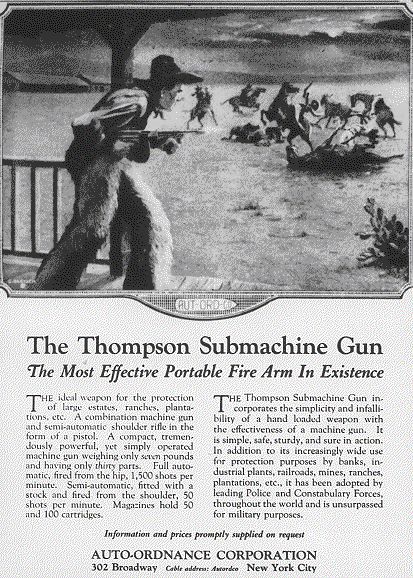
Only in America could a stereotypical chaps-wearing cowboy in a ten-gallon hat and bandanna mow down rustlers (and their horses) with a submachine gun that he had purchased through a mail-order catalog and had delivered straight to his door.
Prior to the passage of the National Firearms Act (NFA) in 1934, anyone with the money could buy automatic weapons and explosives through catalog mail order. The TSMG (along with dynamite and blasting caps) was listed in the 1925 Sears-Roebuck catalog, retailing for $175-$200 at a time when a new Ford automobile cost about $400 and a pre-Depression factory worker might have made as much as $200 a month. So, for most denizens of flyover country, the TSMG remained tantalizingly out of reach, although local hardware stores that sold the TSMG would sometimes offer hourly rental.
During the 1920’s and 1930’s, the USPS routinely armed its personnel with TSMG’s and other weapons to help prevent mail robberies. During this same timeframe, many companies paid their employees with cash, and payroll guards armed with TSMG’s were often employed to provide security for the paymaster. This practice was discontinued when payroll checks begin taking the place of cash, and companies frequently donated their TSMG’s to local sheriffs’ departments for the tax deduction.
Meanwhile, J. Edgar Hoover wasn’t about to let the FBI be outgunned by the criminal element, and he saw to it that his agents had TSMG’s, and plenty of them. By the early 1920’s, oil boomtowns had begun appearing all over Texas, attracting organized crime. Thus, the Texas Rangers, like the FBI, armed themselves to the teeth with TSMG’s and other fully automatic weapons such as the Browning Automatic Rifle (BAR). The following image is of a TSMG used in active duty during this time, as found in the Texas Rangers Museum in Waco, Texas. Note the hard case in which sales to law enforcement were furnished.

©WTM
The TSMG’s high retail price prevented John Q. Public from buying them as he might a .22 rifle but purchases by the criminal element were significant, and the high retail price was merely part of the cost of their doing business. Although many TSMG’s and BAR’s were later stolen from sheriffs’ and police departments and National Guard Armories, automatic weapons used by criminals prior to 1934 were most often just purchased over the counter.
The first known criminal use of the TSMG was in Chicago in 1925, when a bootlegger was standing at the corner of 63rd and Western. A caravan of cars drove by and began firing a hail of bullets. Their aim was bad due to muzzle rise at the high cyclic firing rate (a phenomenon that led to development of a muzzle brake known as the Cutts Compensator) and the bullets flew overhead and embedded in the brickwork, where they remain visible today. Chicago's deadliest year in the Roaring Twenties was 1928, when 333 murders are known to have been committed with the TSMG.
The fact that the TSMG featured in a few spectacular front-page crimes did nothing to help its image with the military. The best known of these crimes is the notorious "St. Valentine's Day Massacre" of 1929, when henchmen of Al Capone mowed down seven members of the "Bugs" Moran gang in a Chicago garage using TSMG’s.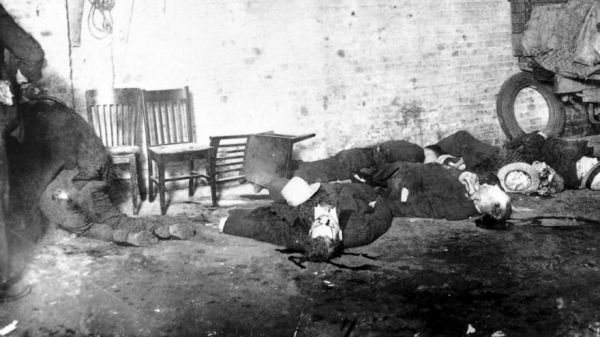
Except for drive-by shootings as seen in The Untouchables, and special events such as the St. Valentine’s Day Massacre, the truth is, the TSMG was really no more popular with most criminals during the Roaring Twenties than ‘assault rifles’ are with non-ideological criminals today, and for the same reason – concealability, or rather, the lack of it. (The stereotyped tommy-gun-in-the-violin/cello-case ploy probably worked for about a week).
 (Image credit: C. Corleis)
(Image credit: C. Corleis)
1930’s - The Threadbare Thirties
By the 1930’s, the TSMG had a large following and a surprisingly large number of nicknames, such as the “Thompson”, “Tommy Gun", "Trench Broom", "Trench Sweeper", “Anti-Bandit Gun”, "Chicago Piano", "Chicago Typewriter", “Chicago Organ Grinder”, “Annihilator”, “Persuader”, “Chattergun”, “Gangster Gun”, and "Chopper". Criminals most often used the terms ‘Tommy Gun’ and ‘Chopper’.
The end of Prohibition in 1933 also meant the end of the gangland ‘Beer Wars’ that had begun in 1920. Organized crime, having been given a jump-start by Prohibition, now moved on to other illegal revenue sources such as drugs, highjackings, and racketeering. The decade of the Great Depression, a time when the exploits of independent criminal gangs such as those of John Dillinger were front-page news, consequently also became known as the “Public Enemy Era”.
Although the proportion of TSMG’s misused by Prohibition-era gangsters and Depression-era bandits was minuscule compared to the thousands used by lawmen and security officers, it is their employment by hoodlums that is naturally best remembered. In part, Hollywood and the likes of Edward G. Robinson, Paul Muni, and James Cagney are responsible for this.
Another reason for the TSMG’s bad press is that it saw the most illegal use in a day and age when some criminal gangs actually sent out press releases, e.g., "The Ballad of Bonnie and Clyde." The criminals loved the notoriety and a Depression-weary public looking for escape ate it up. The TSMG was merely an innocent bystander.
The TSMG was very popular with Depression-era bandits such as Bonnie and Clyde, who had little or no need for concealability. The infamous George "Machine Gun" Kelly got his nickname from the TSMG he preferentially used. TSMG’s were a favorite weapon for Public Enemy No.1, John Dillinger. The Dillinger-Nelson gang liked to carry TSMG’s with the buttstock removed and a 20-round magazine in place (ironically, the exact same configuration as first conceived by General Thompson). The gun could then easily be concealed under an overcoat and used with one hand.
It was their indiscriminate spray-and-pray-with-the-chopper tactic that sealed the fate of the likes of John Dillinger, Pretty Boy Floyd, Bonnie and Clyde, Ma Barker, and Baby Face Nelson, for each had made the fatal error of murdering FBI agents and police with the TSMG or other automatic weapons such as the BAR. Under these circumstances, there would be no further effort to apprehend them alive, and all were killed in furious gun battles or ambushes without even being given a chance to surrender. One notable exception was George “Machine Gun“ Kelly, as seen here.
The pre-1934 TSMG had numerous variations throughout its life, the chief of these being the Model 1921, Model 1923, Model 1927, Model 1928, and Model 1928A1. Each successive model was an improvement over the previous and was also of lower cost. But, due to the rising public fear of easily available automatic weapons in the hands of criminals, the party ended with the 1934 passage of the NFA, which required buyers to pay a $200 tax on each machine gun purchase and register the weapon with the Federal government before delivery.
With the military market still closed, the law enforcement market saturated, and the civilian market now hamstrung, Auto-Ordnance nearly went bankrupt. It was sold in 1939 for little more than the value of its existing inventory, becoming a subsidiary of the Thompson Automatic Arms Company. European sales were all that kept it going.
1940’s - The Fightin' Forties
Early in 1940, it was the image of Winston Churchill, defiantly brandishing both cigar and TSMG, which gave punch to his famous words: ”We shall never surrender."
As for General Thompson, he was never to live to see the overwhelming success of the TSMG as a military weapon during WWII and beyond. He died in 1940 at the age of 80, grieved that “evil men” had appropriated his gun and used it for purposes far outside the Auto-Ordnance motto, "On the side of law and order".
The start of WWII in Europe saved Auto-Ordnance from bankruptcy. With war now inevitable, the US Military finally expressed great interest in the TSMG. Military models were the M1 and M1A1, lower cost versions of the Model 1928A1, designed to be more suitable for the harsh conditions of the battlefield. Still too expensive to be produced en masse, the M1A1 was soon superseded by the low-cost M3A1 ‘greasegun’. The last military TSMG rolled off the line in early 1944, and there were huge arsenal stockpiles of them by the end of WWII.
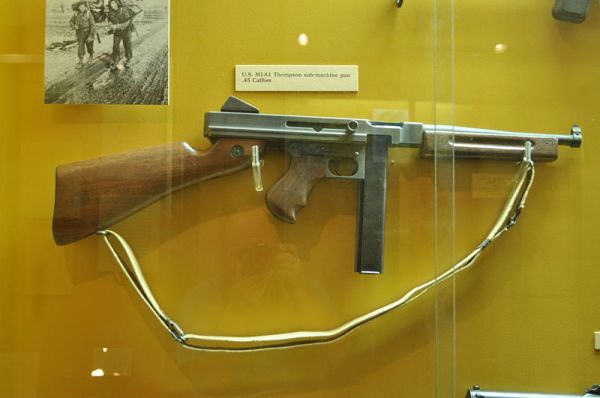 (Image credit: Joe Mabel)
(Image credit: Joe Mabel)
The TSMG was most popular among elite troops such as Army Rangers, Marine Raiders, armored and parachute units. It became somewhat of a status symbol and was eagerly sought after. Even today many veterans consider it the best weapon of WWII. Both German and Japanese troops feared it, as its .45 ACP ball ammunition would take a man down nearly every time, regardless of where he was hit.
 (Image credit: Staff Sergent Walter F. Kleine)
(Image credit: Staff Sergent Walter F. Kleine)
1950’s - The Fabulous Fifties
The TSMG also saw extensive use during the Korean War, as well as with the Secret Service in the 1950 Battle of Blair House, but it was cinema that really showcased it. Besides being featured in gangster films, the TSMG played a prominent role in films such as 1954’s THEM!, where it was used quite effectively against giant ants.
During the 1950’s, Auto-Ordnance was owned and operated by Numrich Arms Corporation, which produced limited numbers of TSMG’s from existing M1928A1 and M1A1 model receivers found in unopened crates purchased in 1951 for use by law enforcement.
1960’s - The Swingin' Sixties
The TSMG saw limited use during the Vietnam War. The Federal Government sold off much of its post-WWII stockpile to other nations, and then began destroying or demilitarizing the rest. However, 1960’s television prominently featured the TSMG, as seen in The Untouchables TV series.
Even Star Trek: The Original Series got into the act with one of its most delightful episodes, ‘A Piece of the Action’.
1970’s – Today
Military use of the TSMG continued to decline, and it is virtually nonexistent today, although some third-world countries still use it as a military weapon. Some isolated domestic law enforcement agencies still make it part of their arsenals. Nearly all existing stocks of M1 and M1A1 TSMG’s have been sold, destroyed, or demilitarized.
In 1974, the Numrich incarnation of Auto-Ordnance made a few full-auto TSMG’s and numerous semi-automatic replicas for the collectors' market. Auto-Ordnance Corporation (by now no relation to the original 1916 AOC) was bought out in 1999 by Saelio Enterprises Inc., parent company of Kahr Arms. Kahr continues to make semi-automatic "Thompson Carbines" in .45 ACP, and outwardly they appear to be identical to their selective-fire (full-auto) predecessors.
 ©WTM
©WTM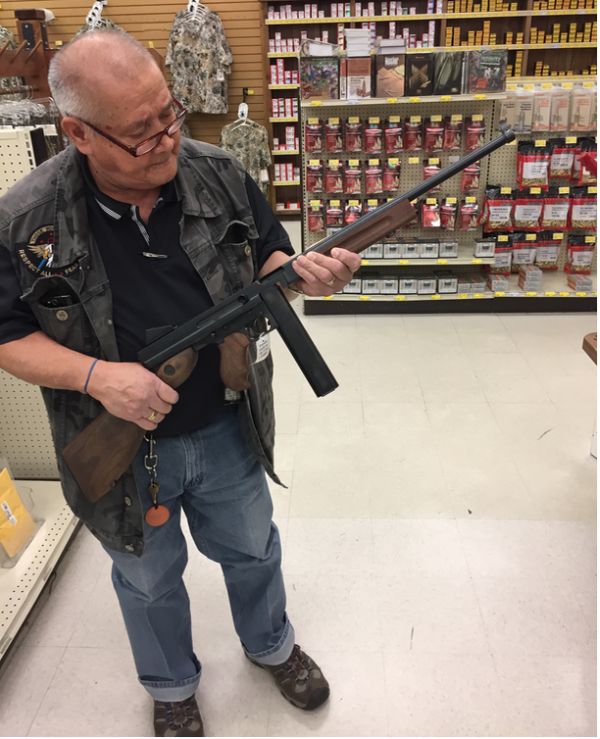 ©WTM
©WTM ©WTM
©WTM
The TSMG still sees limited use in cinema, such as the 2005 remake of King Kong, in which it was again used to battle giant insects, this time Hollywood-style.
And who can forget Tom Hanks as Capt. John Miller with his M1A1 TSMG in 1998’s Saving Private Ryan?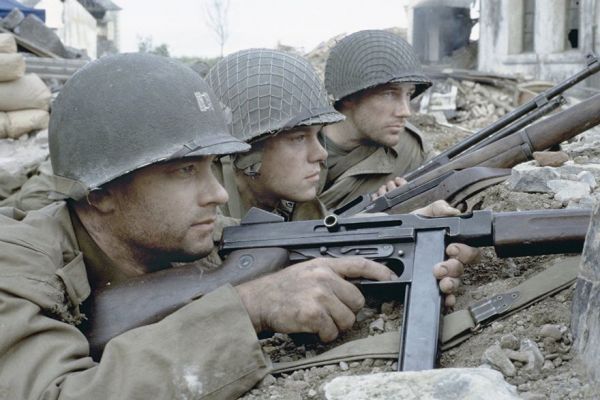
The TSMG has long been out of production, but the legend of the TSMG lives on today. Obsolete, a mere shadow of its former self, and superseded in practically all venues by more modern, more effective, and more economical automatic weapons, the iconic TSMG has, after the passage of nearly a century of both legal and illegal use, been firmly cemented in America’s cultural history as The Gun That Made the Twenties Roar. 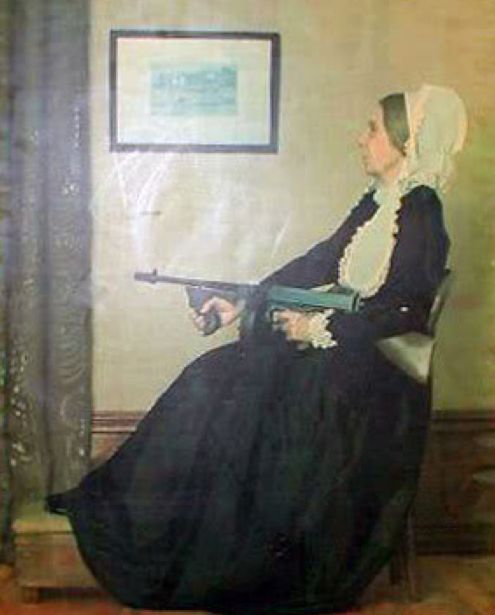
Sources and Further Reading
Auto-Ordnance
Unmistakable: The Thompson
The Echo of the Thompson Gun
Tommy Gun Facts
Thompson Submachine Gun Has its Start in Chicago
M1 Thompson (Tommy Gun) Submachine Gun (SMG)
The Lore of Guns
The First Production Sub Machinegun
John Taliaferro Thompson at Find a Grave
John Blish at Find a Grave
Thomas Fortune Ryan at Find a Grave





